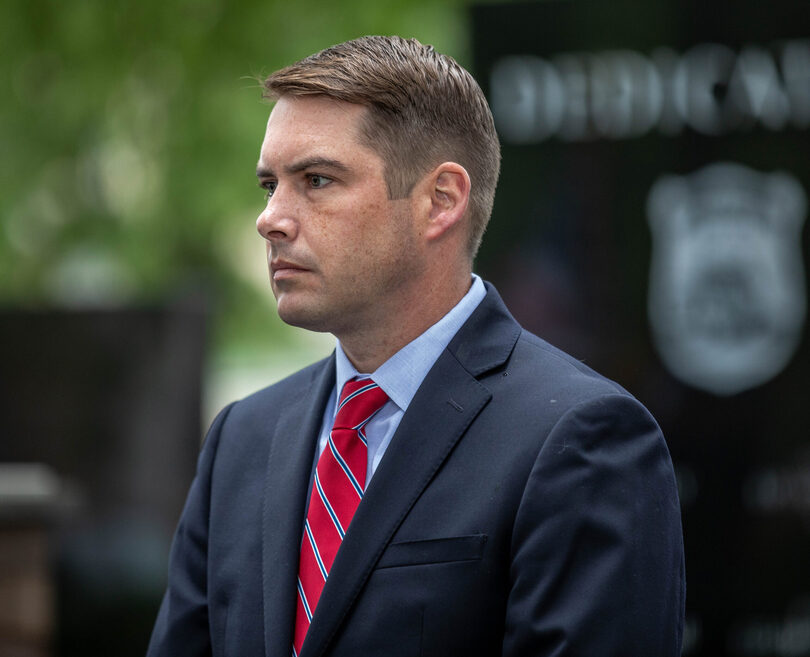Mayor Ben Walsh is focused on learning from past mistakes in I-81 Community Grid

Daily Orange File Photo
Mayor Ben Walsh said the community grid is “not going to displace any housing,” and supported the grid as an alternative since other options, such as a higher viaduct, would have resulted in more displacement.
Get the latest Syracuse news delivered right to your inbox.
Subscribe to our newsletter here.
From the beginning of the Interstate 81 viaduct project, Syracuse Mayor Ben Walsh has had a top priority: to center the city’s efforts around mitigating damages done to those who “live within the shadow of the viaduct.”
“Until we do, I understand that certain stakeholders are going to be skeptical, especially those that have historically been marginalized by these projects,” Walsh said. “That is the most significant metric for success, as far as I’m concerned.”
The I-81 viaduct currently runs through the historical 15th ward, a Black neighborhood, and displaced more than 1,300 families with its construction in the 1960s. The decision to demolish the viaduct was finalized on Feb. 2 after a New York state appeals court dismissed Renew 81 for All’s lawsuit that halted much of the project.
The viaduct will now be replaced with the community grid — a re-imagined roadway including roundabouts, more green space adjacent to Dr. King Elementary and a redesigned, pedestrian-friendly Almond Street, according to New York State’s Department of Transportation website.
The city of Syracuse announced the Community Grid Vision Plan on Feb. 21. The vision plan is a detailed list of additional quality-of-life improvements in conjunction with the community grid, such as more efficient buses and public transportation, bike and pedestrian routes and improved streets. Walsh attended the city’s two informational open houses on the North and South Side neighborhoods last week to discuss the project.
Ellyn Lentz, a 72-year-old Syracuse resident who lives in the University Hill neighborhood, attended Wednesday’s open house at Lincoln Middle School. She said she supports the demolition of the viaduct and the creation of the community grid.
“It’s something that needed to be done for many, many, many years,” she said. “I’m happy to see that it is going to happen and very excited for our city and our whole community, extending beyond even Onondaga County.”
However, Lentz said she worries that low-income communities will again be displaced by the community grid.
“I wish it could happen faster for people who have been so negatively affected by (I)-81, still being (here for) what should be a vibrant part of our city,” Lentz said.
Walsh said the community grid is “not going to displace any housing,” and supported the grid as an alternative since other options, such as a higher viaduct, would have resulted in more displacement. The Viaduct Alternative — which would involve a full reconstruction of I-81 and a new viaduct built to reflect “current design standards” — would have required the acquisition of 24 buildings, according to NYSDOT.
Under the Community Grid Vision Plan’s interactive map, a series of “Community Grid Concept Buildings” overlay many of the Syracuse Housing Association’s current parcels, including much of Pioneer Homes. Though, Walsh called the vision plan a “dynamic, fluid plan that is going to continue to change” at the Lincoln Middle School open house.
Walsh said the city is learning from past mistakes and that community concerns are warranted until the city delivers on its plans. Similar projects have been undertaken without considering the best interests of marginalized communities and communities of color, he added.
“If that is not the outcome, then we would have failed the community,” Walsh said.
Lentz is not alone in her skepticism of the community grid’s construction. Syracuse University Associate Professor of architecture Lawrence Davis also expressed concern and doubt about whether the city will be able to equitably construct the community grid.
“I’m also concerned about the existing residents, particularly on the South Side — Pioneer Homes, that area,” Davis said. “That’s a community that’s been there a long time. And if you were to sort of displace them, then that might be a problem right away.”
Walsh said the community grid project will free up parcels of land. Joe Driscoll, the I-81 project director, said land near Dr. King Elementary School, which in earlier versions of the project was going to be a roundabout, will be freed up by the project.
The current viaduct stands adjacent to Pioneer Homes, contained in one of Syracuse’s poorest neighborhoods, which has already struggled with lead paint in homes. Lentz said she is worried that the demolition will further impact the poor living conditions.
“I just think if it was me, I would be very much kind of a wreck, especially if I had kids,” she said.
The city has additionally discussed grant funding for a project with SUNY ESF to monitor air quality during construction, Driscoll said. He added that there is a “working group” meeting with the New York State Department of Transportation to share concerns about air quality and potential lead exposure from lead paint on the viaduct.
If that is not the outcome, then we would have failed the community.Mayor Ben Walsh
While the city is concerned about air quality, the long-term environmental impact of the community grid will result in a “net positive impact” on air quality, according to an analysis done by the NYSDOT, Walsh said. He said he is confident that these concerns will be “effectively mitigated.”
“There will definitely be an improvement of quality of life of whoever’s in that corridor because we will not be polluting at such a high rate and causing (as) many negative health outcomes (as) the elevated viaduct,” Driscoll said.
Walsh said he is now aiming to focus the community on the “task at hand.” To him, the community grid has always been the right option for the viaduct, especially as lots of time and money have already been wasted on legal proceedings to further the project, he said.
“We are focused on doing it differently and doing it right and learning from the mistakes of the past. But we understand that until we actually do it, until we actually deliver on what we’re saying we’re going to, many people are going to be skeptical,” Walsh said. “I don’t begrudge that skepticism. I understand it, but we are all very laser-focused on overcoming it.”





